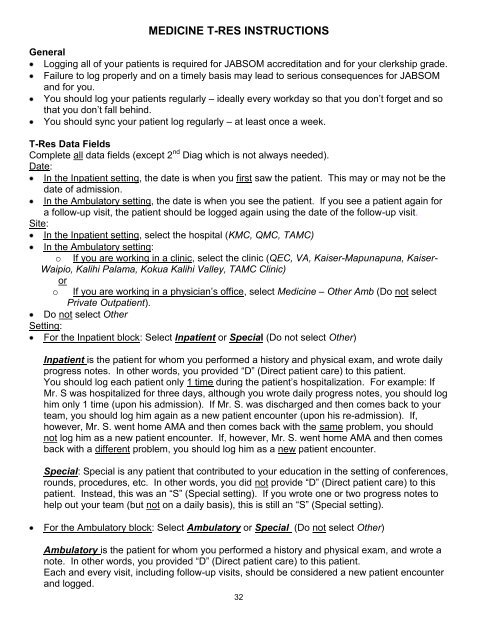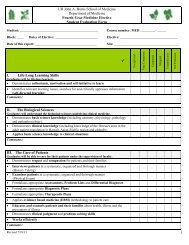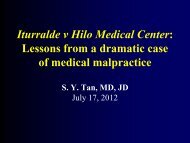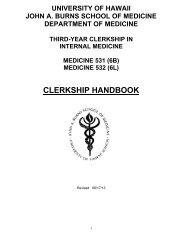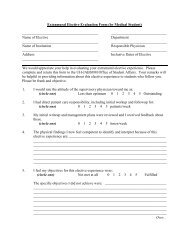clerkship handbook - University of Hawaii â Department of Medicine
clerkship handbook - University of Hawaii â Department of Medicine
clerkship handbook - University of Hawaii â Department of Medicine
Create successful ePaper yourself
Turn your PDF publications into a flip-book with our unique Google optimized e-Paper software.
MEDICINE T-RES INSTRUCTIONS<br />
General<br />
Logging all <strong>of</strong> your patients is required for JABSOM accreditation and for your <strong>clerkship</strong> grade.<br />
Failure to log properly and on a timely basis may lead to serious consequences for JABSOM<br />
and for you.<br />
You should log your patients regularly – ideally every workday so that you don’t forget and so<br />
that you don’t fall behind.<br />
You should sync your patient log regularly – at least once a week.<br />
T-Res Data Fields<br />
Complete all data fields (except 2 nd Diag which is not always needed).<br />
Date:<br />
In the Inpatient setting, the date is when you first saw the patient. This may or may not be the<br />
date <strong>of</strong> admission.<br />
In the Ambulatory setting, the date is when you see the patient. If you see a patient again for<br />
a follow-up visit, the patient should be logged again using the date <strong>of</strong> the follow-up visit.<br />
Site:<br />
In the Inpatient setting, select the hospital (KMC, QMC, TAMC)<br />
In the Ambulatory setting:<br />
o If you are working in a clinic, select the clinic (QEC, VA, Kaiser-Mapunapuna, Kaiser-<br />
Waipio, Kalihi Palama, Kokua Kalihi Valley, TAMC Clinic)<br />
or<br />
o<br />
If you are working in a physician’s <strong>of</strong>fice, select <strong>Medicine</strong> – Other Amb (Do not select<br />
Private Outpatient).<br />
Do not select Other<br />
Setting:<br />
For the Inpatient block: Select Inpatient or Special (Do not select Other)<br />
Inpatient is the patient for whom you performed a history and physical exam, and wrote daily<br />
progress notes. In other words, you provided “D” (Direct patient care) to this patient.<br />
You should log each patient only 1 time during the patient’s hospitalization. For example: If<br />
Mr. S was hospitalized for three days, although you wrote daily progress notes, you should log<br />
him only 1 time (upon his admission). If Mr. S. was discharged and then comes back to your<br />
team, you should log him again as a new patient encounter (upon his re-admission). If,<br />
however, Mr. S. went home AMA and then comes back with the same problem, you should<br />
not log him as a new patient encounter. If, however, Mr. S. went home AMA and then comes<br />
back with a different problem, you should log him as a new patient encounter.<br />
Special: Special is any patient that contributed to your education in the setting <strong>of</strong> conferences,<br />
rounds, procedures, etc. In other words, you did not provide “D” (Direct patient care) to this<br />
patient. Instead, this was an “S” (Special setting). If you wrote one or two progress notes to<br />
help out your team (but not on a daily basis), this is still an “S” (Special setting).<br />
For the Ambulatory block: Select Ambulatory or Special (Do not select Other)<br />
Ambulatory is the patient for whom you performed a history and physical exam, and wrote a<br />
note. In other words, you provided “D” (Direct patient care) to this patient.<br />
Each and every visit, including follow-up visits, should be considered a new patient encounter<br />
and logged.<br />
32


